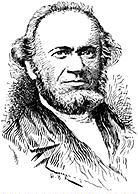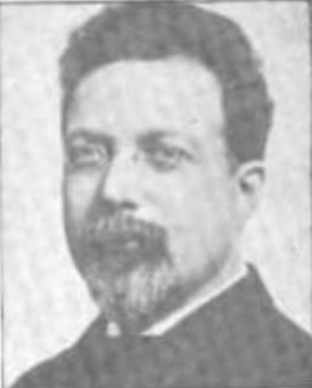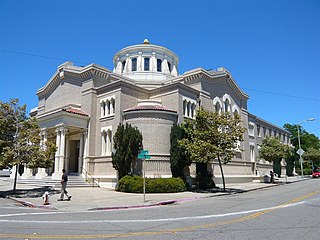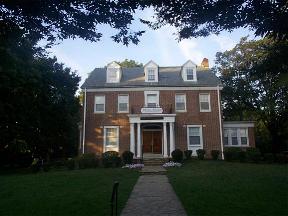
Reform Judaism, also known as Liberal Judaism or Progressive Judaism, is a major Jewish denomination that emphasizes the evolving nature of Judaism, the superiority of its ethical aspects to its ceremonial ones, and belief in a continuous revelation which is closely intertwined with human reason and not limited to the theophany at Mount Sinai. A highly liberal strand of Judaism, it is characterized by little stress on ritual and personal observance, regarding Jewish law as non-binding and the individual Jew as autonomous, and by a great openness to external influences and progressive values.

Emil Gustav Hirsch was a Luxembourgish-born Jewish American biblical scholar, Reform rabbi, contributing editor to numerous articles of The Jewish Encyclopedia (1906), and founding member of the NAACP.

David Einhorn was a German rabbi and leader of Reform Judaism in the United States. Einhorn was chosen in 1855 as the first rabbi of the Har Sinai Congregation in Baltimore, the oldest congregation in the United States that has been affiliated with the Reform movement since its inception. While there, he created an early American prayer book for the congregation that became one of the progenitors of the 1894 Union Prayer Book. In 1861, Einhorn was forced to flee to Philadelphia, where he became rabbi of Reform Congregation Keneseth Israel. He moved to New York City in 1866, where he became rabbi of Congregation Adath Israel.

The West London Synagogue of British Jews, abbreviated WLS, is a synagogue and congregation near Marble Arch in central London. It was established on 15 April 1840. The current synagogue building in Upper Berkeley Street, dedicated in 1870, is Grade II listed. It is one of the oldest synagogues in the United Kingdom and it was the oldest house of prayer affiliated with the Movement for Reform Judaism, before its affiliation lapsed in February 2023.

Kaufmann Kohler was a German-born Jewish American biblical scholar and critic, theologian, Reform rabbi, and contributing editor to numerous articles of The Jewish Encyclopedia (1906).

Congregation Beth Elohim, also known as the Garfield Temple and the Eighth Avenue Temple, is a Reform Jewish congregation located at 274 Garfield Place and Eighth Avenue, in the Park Slope neighborhood of Brooklyn in New York City, United States.

The Liberal Jewish Synagogue, or LJS, is a house of prayer in St John's Wood, London, founded in 1911. It is the oldest and largest member of Britain's Liberal Judaism, a constituent member of the World Union for Progressive Judaism.
Congregation Shomrei Emunah is an Orthodox Jewish synagogue in the Greenspring neighborhood of Baltimore, Maryland. Rabbi Binyamin Marwick is the synagogue's rabbi.

Abraham Joseph Rice was the first ordained rabbi to serve in a rabbinical position in the United States.

David Philipson was an American Reform rabbi, orator, and author.

Temple Sinai is a Reform synagogue located at 2808 Summit Street in Oakland, California, United States. Founded in 1875, it is the oldest Jewish congregation in the East San Francisco Bay region.

Congregation Beth Israel is a Jewish congregation located at 10460 North 56th Street in Scottsdale, Arizona. Formally incorporated in 1920, it affiliated with the Reform Judaism in 1935.
The Union Prayer Book was a Siddur published by the Central Conference of American Rabbis to serve the needs of the Reform Judaism movement in the United States.

Minhag America is a siddur created in 1857 by Rabbi Isaac Mayer Wise that was intended to address conflict between sides supporting and opposing traditionalism in early Reform Judaism in the United States. The prayer book was accepted by the majority of Reform congregations in the western and southern United States.

Temple Emanuel Sinai is a medium-sized Reform (progressive) Jewish synagogue located in Worcester, Massachusetts, New England's second largest city.

Temple Israel is a Reform Jewish congregation and synagogue located at 2004 East 22nd Place in Tulsa, Oklahoma, in the United States. Founded in 1914, the congregation affiliated with the Union for Reform Judaism in 1915, and constructed its first building on the corner of 14th and Cheyenne Streets in 1919. Early rabbis included Jacob Menkes, Charles Latz, Samuel Kaplan, Jacob Krohngold, and Benjamin Kelsen.
Reverend Dr. Jacob Mayer was a European-born American rabbi who served congregations in the Reform Judaism movement in the late 19th century. He obtained the pulpit in 1874 at Har Sinai Congregation in Baltimore, founded in 1842 and the longest continually functioning congregation adhering to Reform since its inception. Mayer was forced to leave two years later amid charges that he had been an apostate who had converted to Christianity and had been a missionary in Africa, though he vigorously denied the charges.

Few Jews arrived in Baltimore, Maryland, in its early years. As an immigrant port of entry and border town between North and South and as a manufacturing center in its own right, Baltimore has been well-positioned to reflect developments in American Jewish life. Yet, the Jewish community of Baltimore has maintained its own distinctive character as well.

Reform Congregation Keneseth Israel, abbreviated as KI, is a Reform Jewish congregation and synagogue located at 8339 Old York Road, Elkins Park, just outside the city of Philadelphia, Pennsylvania, in the United States. Founded in Philadelphia in 1847, it is the sixth oldest Reform congregation in the United States, and, by 1900, it was one of the largest Reform congregations in the United States. The synagogue was at a number of locations in the city before building a large structure on North Broad Street in 1891, until 1956 when it moved north of the city to suburban Elkins Park.

Moses Hutzler was a German-born American businessman and co-founder of the first Reform Jewish congregation in the United States, Har Sinai.


















